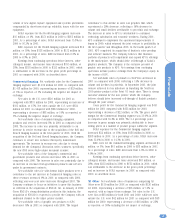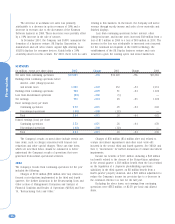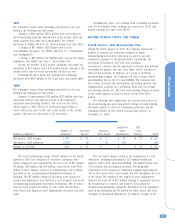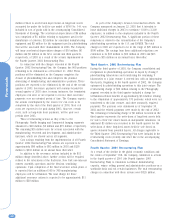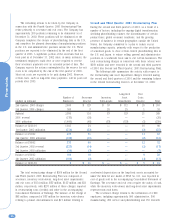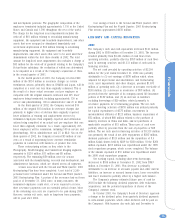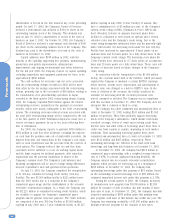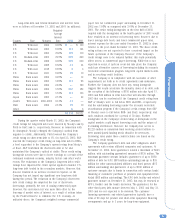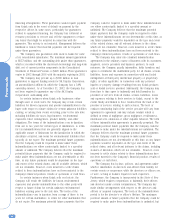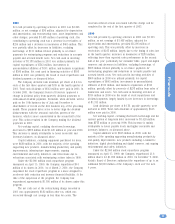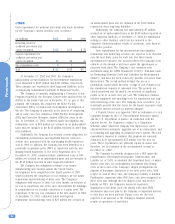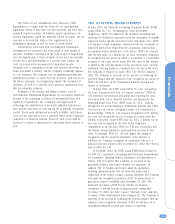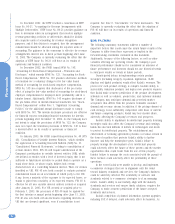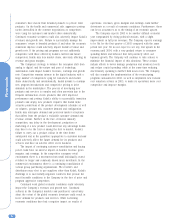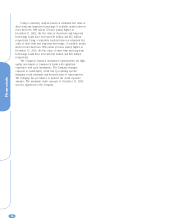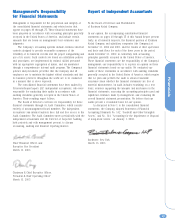Kodak 2002 Annual Report Download - page 29
Download and view the complete annual report
Please find page 29 of the 2002 Kodak annual report below. You can navigate through the pages in the report by either clicking on the pages listed below, or by using the keyword search tool below to find specific information within the annual report.
Financials
29
would be affected by all relevant defenses to the claims, including
statutes of limitations.
The Company had a commitment under a put option
arrangement with Burrell Colour Lab (BCL), an unaffiliated
company, whereby the shareholders of BCL had the ability to put
100% of the stock to Kodak for total consideration, including the
assumption of debt, of approximately $63.5 million. The option
first became exercisable on October 1, 2002 and was ultimately
exercised during the Company’s fourth quarter ended
December 31, 2002. Accordingly, on February 5, 2003, the
Company acquired BCL for a total purchase price of
approximately $63.5 million, which was composed of
approximately $53 million in cash and $10.5 million in assumed
debt. The exercise of the option had no impact on the Company’s
fourth quarter earnings.
In connection with the Company’s investment in China that
began in 1998, certain unaffiliated entities invested in two Kodak
consolidated companies with the opportunity to put their minority
interests to Kodak at any time after the third anniversary, but
prior to the tenth anniversary, of the date on which the
companies were established. On December 31, 2002, an
unaffiliated investor in one of Kodak’s China subsidiaries exercised
their rights under the put option agreement. Under the terms of
the arrangement, the Company repurchased the investor’s 10%
minority interest for approximately $44 million in cash. The
exercise of this put option and the recording of the related
minority interest purchased had no impact on the Company’s
earnings. The total exercise price in connection with the
remaining put options, which increases at a rate of 2% per
annum, is approximately $60 million at December 31, 2002. The
Company expects that approximately $16 million of the remaining
$60 million in total put options will be exercised and the related
cash payments will occur over the next twelve months.
Due to the continuing declines in the equity markets in 2002
as well as the decline in the discount rate from December 31,
2001 to December 31, 2002, the Company was required to record
a charge to the accumulated other comprehensive (loss) income
component of equity of $394 million, net of tax benefits of $183
million, for additional minimum pension liabilities at December 31,
2002. The increase in additional minimum pension liabilities of
$577 million was recorded to the postretirement liabilities
component on the Consolidated Statement of Financial Position at
December 31, 2002. The net increase in this component of $684
million from December 31, 2001 to December 31, 2002 is
partially attributable to this increase in the additional minimum
pension liabilities. The Company recorded the deferred income tax
benefit of $183 million in the other long-term assets component
within the Consolidated Statement of Financial Position. The net
increase in this component of $296 million from December 31,
2001 to December 31, 2002 is partially attributable to the
recording of these deferred income tax assets and the increase in
the prepaid pension asset. The increase in the prepaid pension
asset is primarily attributable to $197 million of pension income
generated from the U.S. pension plans in 2002.
During the fourth quarter of 2002, the Company funded one
of its non-U.S. defined benefit plans in the amount of
approximately $38 million. The Company does not expect to have
significant funding requirements relating to its defined benefit
pension plans in 2003.
Qualex, a wholly owned subsidiary of Kodak, has a 50%
ownership interest in Express Stop Financing (ESF), which is a
joint venture partnership between Qualex and Dana Credit
Corporation (DCC), a wholly owned subsidiary of Dana
Corporation. Qualex accounts for its investment in ESF under the
equity method of accounting. ESF provides a long-term financing
solution to Qualex’s photofinishing customers in connection with
Qualex’s leasing of photofinishing equipment to third parties, as
opposed to Qualex extending long-term credit. As part of the
operations of its photofinishing business, Qualex sells equipment
under a sales-type lease arrangement and records a long-term
receivable. These long-term receivables are subsequently sold to
ESF without recourse to Qualex. ESF incurs long-term debt to
finance the purchase of the receivables from Qualex. This debt is
collateralized solely by the long-term receivables purchased from
Qualex and, in part, by a $60 million guarantee from DCC.
Qualex provides no guarantee or collateral to ESF’s creditors in
connection with the debt, and ESF’s debt is non-recourse to
Qualex. Qualex’s only continued involvement in connection with
the sale of the long-term receivables is the servicing of the
related equipment under the leases. Qualex has continued
revenue streams in connection with this equipment through future
sales of photofinishing consumables, including paper and
chemicals, and maintenance.
Qualex has risk with respect to the ESF arrangement as it
relates to its continued ability to procure spare parts from the
primary photofinishing equipment vendor (the Vendor) to fulfill its
servicing obligations under the leases. This risk is attributable to
the fact that, throughout 2002, the Vendor was experiencing
financial difficulty which ultimately resulted in certain of its
entities in different countries filing for bankruptcy on December
24, 2002. Although the lessees’ requirement to pay ESF under
the lease agreements is not contingent upon Qualex’s fulfillment
of its servicing obligations, under the agreement with ESF, Qualex
would be responsible for any deficiency in the amount of rent not
paid to ESF as a result of any lessee’s claim regarding
maintenance or supply services not provided by Qualex. Such
lease payments would be made in accordance with the original
lease terms, which generally extend over 5 to 7 years. ESF’s
outstanding lease receivable amount was approximately $473
million at December 31, 2002.
To mitigate the risk of not being able to fulfill its service
obligations in the event the Vendor were to file for bankruptcy,
Qualex built up its inventory of these spare parts during 2002
and began refurbishing used parts. To further mitigate its
exposure, effective April 3, 2002, Kodak entered into certain
agreements with the Vendor under which the Company paid $19
million for a license relating to the spare parts intellectual
property, an equity interest in the Vendor and the intellectual


